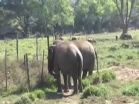(Press-News.org) This news release is available in German.
Until now, it has been a time-consuming process for a program to arrange pictures in a consistent order. It is even more complex to order them on the basis of visual characteristics. Computer scientists from Saarbrücken have developed a system to arrange pictures into a consistent order. It requires no more than a small number of pre-sorted example pictures. Operators of online portals or museums could use this technique, for example, to arrange complex datasets.
So far, if a nature photographer wanted to arrange pictures of various butterflies systematically based on color or size to create an illustrated book, he needed a lot of time: He would have to arrange the individual pictures of the animals on the computer by hand to bring them into the requested order. Suitable software that would have been able to arrange pictures automatically based on certain characteristics did not exist.
Researchers at the Max Planck Institute for Informatics in Saarbrücken in the research group of Tobias Ritschel developed a method that makes it possible to arrange numerous pictures very fast. An algorithm orders them according to certain visual characteristics such as size and intensity. In so doing, the algorithm distributes the pictures consistent over the free space on the screen in such a way that they create a harmonious overall picture. "The main feature of our program is that it is able to capture the requests of the user", explains Ritschel, who is the head of the research group "Rendering and GPUs". "All he has to do is to click on three or more pictures with the mouse and drag them to certain points; for example, he places two up in the left corner and the other one down in the right corner. Following on this, the program calculates the requested order and arranges the picture correspondingly.
This method provides novel possibilities not only for photographers and photo editors, but also for online shops. "On the one hand, the operators of such shops could represent their products in a more compact and visually pleasing way than before", says Bernhard Reinert, who played a leading role within the development process. "On the other hand, our program works very flexibly, so that web designers can easily create their websites for different end-user devices like computers or smart phones". Moreover, museums could use this program for their exhibitions so that, for example, children could learn playfully by arranging pictures of coins, rocks or animals.
Reinert and his colleagues are already in conversation with prospective customers. In the next months, they want to improve their method in such a way that software is able to arrange pictures in three-dimensional space.
INFORMATION:
The computer scientists show their system at the computer expo Cebit from the 10th until the 14th of March in Hanover (hall 9, booth E13).
Background information about computer science research at Saarland University in Saarbrücken
The Department of Computer Science represents the center of computer science research in Saarbrücken. Seven other world-renowned research institutes are close by: The Max Planck Institutes for Informatics and for Software Systems, the German Research Center for Artificial Intelligence (DFKI), the Center for Bioinformatics, the Intel Visual Computing Institute, the Center for IT Security, Privacy and Accountability (CISPA) and the Cluster of Excellence "Multimodal Computing and Interaction".
Computer arranges pictures based on their artistic aspects
2014-02-18
ELSE PRESS RELEASES FROM THIS DATE:
Scientists chip away at the mystery of what lives in our mouths
2014-02-18
COLUMBUS, Ohio – Scientists have pieced together sections of DNA from 12 individual cells to sequence the genome of a bacterium known to live in healthy human mouths.
With this new data about a part of the body considered "biological dark matter," the researchers were able to reinforce a theory that genes in a closely related bacterium could be culprits in its ability to cause severe gum disease.
Why the dark matter reference? More than 60 percent of bacteria in the human mouth refuse to grow in a laboratory dish, meaning they have never been classified, named or studied. ...
ASU professor explores the ethics of scientific research and why they matter
2014-02-18
CHICAGO — Discovery and innovation are important to science, but how are they connected to each other, and how can they be fostered to benefit the wider public? Jason Robert, the Lincoln Chair in Ethics and Dean's Distinguished Professor of Life Sciences at Arizona State University discussed that question today (Feb. 16) at the annual meeting of the American Association for the Advancement of Science in Chicago.
"While most of the people at the AAAS meeting are presenting their research results, we're asking scientists to think harder about what they're doing in their ...
Malaria vaccine development paves way for protective therapy
2014-02-18
Scientists have made a significant contribution towards the development of a vaccine to prevent malaria.
Researchers have tested a preliminary form of a vaccine against the disease, which is spread by the bite of the mosquito and kills more than 600,000 people each year.
Until now, developing malaria vaccines has been challenging. A vaccine must incorporate key proteins from the malaria parasites, which will trigger production of antibodies by the immune system. These proteins have a complex, intricate structure that is hard to reproduce.
Scientists at the University ...
Northwestern Medicine researchers discover new way to prevent some strokes
2014-02-18
CHICAGO – Larry Ambrose woke up one night, wandered into his kitchen but couldn't completely read the time on his microwave. A few days later when he noticed his blood pressure was unusually high, he went to the hospital and was diagnosed as having a stroke. Ambrose, like 25 percent of all stroke patients, experienced a cryptogenic stroke, meaning despite numerous tests, physicians were unable to determine a cause.
"There were no warning signs and I felt there was nothing I could do to stop it from happening again," said Ambrose, who is 75 years old. "It's a scary feeling."
For ...
Case Western Reserve University
2014-02-18
Many mothers with children on life-sustaining medical devices, such as ventilators and breathing or feeding tubes, suffer physical and psychological distress from the stress of juggling treatments, appointments, therapies and daily family pressures.
But researchers from the Case Western Reserve University nursing school found that an intervention, called "Resourcefulness," which teaches moms how to better cope, bolsters the mother's wellbeing and, in turn, benefits the whole family.
Findings from a small pilot study of 22 mothers, "Resourcefulness training intervention: ...
Crowdsourced testers prefer new cyber search method
2014-02-18
Computer scientists at Case Western Reserve University have developed a new tool to search and fetch electronic files that saves users time by more quickly identifying and retrieving the most relevant information on their computers and hand-held devices.
Anonymous testers recruited through crowdsourcing preferred the new search tool nearly two-to-one over a keyword-based lookup interface and the most commonly available lookup search interface using Google.
Side-by-side comparisons showed the scientists' Conjunctive Exploratory Navigation Interface (CENI), which combines ...
New technology from CWRU links patient records between hospitals, medical flight crews
2014-02-18
Although trauma, heart and stroke patients benefit from being transferred from a local hospital to a higher-level care facility, it's unclear why patients transferred with non-urgent medical conditions show at least a 30 percent higher death rate than had they stayed put, according to researchers from Case Western Reserve University's nursing school.
"We think the answer is somewhere in the medical records," said Andrew Reimer, PhD, RN, KL2 Scholar instructor at the Dorothy Ebersbach Academic Center for Flight Nursing at Case Western Reserve University's Frances Payne ...
Something's wrong in Washington: Is American democracy in crisis?
2014-02-18
The Federal shutdown may be the most striking evidence to support claims that America's political system is broken, but it is far from the only example. Writing in Governance, acclaimed political scientists Norman Ornstein and Jared Diamond explore if tribalism is at the heart of the problem, or if the U.S. is facing a far greater political crisis.
"The state of our overall political process as the most dysfunctional I have seen in over 44 years of watching Washington and American politics up close," writes Norman Ornstein, from the American Enterprise Institute. "If ...
Asian elephants reassure others in distress
2014-02-18
VIDEO:
Asian elephants console others who are in distress, using physical touches and vocalizations, finds a study to be published in the open-access journal PeerJ. The findings are the first empirical...
Click here for more information.
Asian elephants console others who are in distress, using physical touches and vocalizations, finds a study to be published in the open access journal PeerJ. The findings are the first empirical evidence of consolation in elephants, says ...
Whotspot Makes it Easy To Start Your Own Business
2014-02-18
Whotspot.com a progressive, paradigm shifting, provider of Cloud-managed WiFi products and services has put together 3 new plans to help entrepreneurs "start your own business". These plans can also help existing businesses expand and grow.
"Our systems are so simple, anyone can offer controlled, pay-per-use, voucher limited or free wifi at any venue in a matter of minutes. If you can plug in a lamp, you can deploy one of our wifi gateways", states Terry Fagen, President of Whotspot.com. With these 3 new partner programs, anyone can make money in ...

